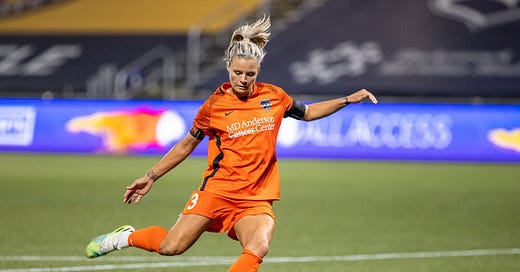What ponytails say about homophobia in women’s football
How heteronormativity survives in women’s football
I sacrificed my ponytail for a long pixie cut in October 2022.
Then, still wanting to go shorter, I navigated several iterations of 13-year-old freshly-cut-schoolboy-picture-day hair before landing on a buzzcut (grade 5 on top and 4 on sides). Not long after, I braved an even shorter buzzcut (grade 3 on top and 2 on sides) to test my limits. The very confused male barber in Kingston asked me twice if it was what I really wanted - as if I’d been forced into it as part of a dare.
Since, I’ve been growing it out and sadly discovered that my thick, straight hair cannot serve a shaggy mullet and now I am resolved to a wavy, layered short bob.
The constants throughout my hair’s turbulent era have been:
1. Feeling more like myself – that is I felt like I was no longer putting on a performance of femininity.
2. Hairdressers’ reticence and inexperience in cutting a hairstyle that might make me look a tiny bit masculine (“Are you sure you want to cut off these beautiful golden locks?”).
3. Having to pay between 30-50% more for the same haircut a man would get.
From this I’ve learned that hair is inextricably tied to acceptable ideas of gender and sexuality, and if sticking to a certain hairstyle in sport was about being practical then we would all have shaved heads.
The freest I felt as a competitive tennis player was when I had a buzz cut. Guaranteed no threats of loose baby hairs, wincing from the pain of how tight a ponytail is, or arguing with plastic hair clips and ties.
I counted just three out of 368 players competing in the women’s euros tournament who have hair that is too short for a bun or ponytail and would be considered gender neutral or masculine.
A quick glance at the FA’s women’s leagues website reveals similarly very few players and some whole squads with no short-haired players - of the few that do, most are of East Asian or Sub-Saharan African background*.
In the queer or LGBT+ spaces I’ve been in there are always at least three women existing along the short hair spectrum, and that’s in a group of between 10 and 30 people.
While English women’s football is hailed as an LGBTQ+ inclusive haven with visible out players, such as Beth Mead, Viv Miedema, Katie McCabe, Jess Carter and Beth England, there are signs heteronormativity (the belief heterosexuality is the norm and there is a gender binary) remains influential.
Ponytails and buns are one of them.
Kari Fastings and Sheila Scraton’s 1997 research on women’s experiences in sport across Europe showed that “the English [football] players used appearance and clothes to resist the stereotype of being a lesbian player. Most said that they often dressed up to avoid comment about being ‘butch’” (p. 5).
In Jayne Caudwell’s 1999 research on women’s players across the United Kingdom she found that “gender frontiers are clearly marked, apparently impermeable and prevalent. These borders are socially and culturally constructed and maintained” (p. 401).
The decades since these studies have seen great progress in acceptance of homosexuality in women’s football, however that doesn’t render them irrelevant nor prove heteronormativity has disappeared.
I argue that current white Western and European players*, like the women in these studies 30 years ago, are consciously or subconsciously using appearance, such as feminine-coded hairstyles like ponytails, buns, and plaits, make-up, certain jewellery and piercings, and lack of tattoos to demonstrate they are ‘real women’.
As footballers who already transgress typical gender boundaries in being muscular and playing in the ‘male preserve’ of football, conforming to standards of femininity is essential to resist stereotypes and implications of being or wanting to be a man.
The bodies of women of colour, transgender and disabled women in football are open to additional surveillance, scrutiny and exclusion as these ideals of femininity have been historically white, cisgender and non-disabled.
As heteronormative cultures breed homophobia and transphobia, harassment, abuse and outright blanket bans have followed to punish those who aren’t ‘woman enough’.
Orlando Pride and Zambia player Barbra Banda, a cisgender woman, faced a deluge of racist and transphobic online abuse after winning BBC women’s footballer of the year in 2024, not long after the York Railway Institute AFC Girls U12 team were subject to derogatory misgendering from opposition and their supporters.
FA Women’s National League player Valentine Pursey revealed in November 2024 that she was subjected to homophobic abuse because of her short hair.
And on 1 June 2025, transgender women were banned from women’s football in England, marking one of the most extreme manifestations of gender policing in women’s football.
So, while being gay may be normalised, it is only the gay and straight women’s footballers who conform to acceptable representations of femininity and womanhood that are permitted.
This is just one of the several, subtle, shifting ways heteronormativity, and consequently homophobia and transphobia, is being kept alive in women’s football.
Don’t let headline-grabbing examples of LGBT+ inclusivity in women’s football let you think otherwise.
*03.07.25 Edits were made to emphasise the white Western / European nature of this trend.




So interesting, thanks Evie. Players who wear full make up, is this a preference or an apology? It’s sad but really important to think deeper about these things.
I note your tennis playing, Evie, what do you think about the men’s Wimbledon Final always chosen as the singles climax on a Sunday. Shouldn’t this be on a rotation basis at least, or more appropriately to drive equality - and challenge it’s historic imbalance - the women’s Final as the climax every year?